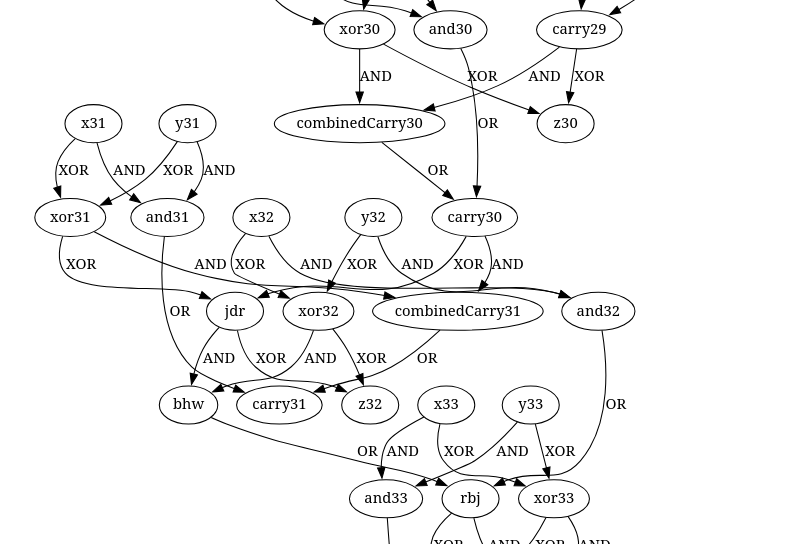- 15 Posts
- 80 Comments

 3·2 days ago
3·2 days agoI struggled for a long time because I had nearly the correct results. I had to switch
divwithquot.This puzzle was fun. If you have a visualization, it’s even cooler. (It’s a fractal)
Haskell Code
{-# LANGUAGE LambdaCase #-} {-# LANGUAGE PatternSynonyms #-} {-# OPTIONS_GHC -Wall #-} module Main (main) where import Text.Read (ReadPrec, Read (readPrec)) import Data.Functor ((<&>)) import Data.Text (pattern (:<), Text) import qualified Data.Text as Text import qualified Data.Text.IO as TextIO import Control.Monad ((<$!>)) import Control.Arrow ((<<<)) newtype Complex = Complex (Int, Int) instance Read Complex where readPrec :: ReadPrec Complex readPrec = readPrec <&> \case [a, b] -> Complex (a, b) _ -> undefined instance Show Complex where show :: Complex -> String show (Complex (a, b))= show [a, b] readAEquals :: Text -> Complex readAEquals ('A' :< '=':< rest) = read $ Text.unpack rest readAEquals _ = undefined -- >>> Complex (1, 1) `add` Complex (2, 2) -- [3,3] add :: Complex -> Complex -> Complex (Complex (x1, y1)) `add` (Complex (x2, y2)) = Complex (x1 + x2, y1 + y2) -- >>> Complex (2, 5) `times` Complex (5, 7) -- [-25,-11] times :: Complex -> Complex -> Complex (Complex (x1, y1)) `times` (Complex (x2, y2)) = Complex (x1 * x2 - y1 * y2, x1 * y2 + x2 * y1) dividedBy :: Complex -> Complex -> Complex (Complex (x1, y1)) `dividedBy` (Complex (x2, y2)) = Complex (x1 `quot` x2, y1 `quot` y2) step :: Complex -> Complex -> Complex step a r = let r1 = r `times` r r2 = r1 `dividedBy` Complex (10, 10) r3 = r2 `add` a in r3 zero :: Complex zero = Complex (0, 0) part1 :: Complex -> Complex part1 a = iterate (step a) (Complex (0, 0)) !! 3 shouldBeEngraved :: Complex -> Bool shouldBeEngraved complexPoint = let cycleStep :: Complex -> Complex -> Complex cycleStep point r = let r2 = r `times` r r3 = r2 `dividedBy` Complex (100000, 100000) in point `add` r3 inRange x = x <= 1000000 && x >= -1000000 in all (\ (Complex (x, y)) -> inRange x && inRange y) <<< take 101 <<< iterate (cycleStep complexPoint) $ zero -- >>> shouldBeEngraved $ Complex (35630,-64880) -- True -- >>> shouldBeEngraved $ Complex (35460, -64910) -- False -- >>> shouldBeEngraved $ Complex (35630, -64830) -- False part2 :: Complex -> Int part2 (Complex (xA, yA)) = let xB = xA + 1000 yB = yA + 1000 in length . filter shouldBeEngraved $ do x <- [xA, xA+10.. xB] y <- [yA, yA+10.. yB] pure $ Complex (x, y) part3 :: Complex -> Int part3 (Complex (xA, yA)) = length . filter shouldBeEngraved $ do x <- [xA..xA+1000] y <- [yA..yA+1000] pure $ Complex (x, y) -- >>> [0, 10..100] -- [0,10,20,30,40,50,60,70,80,90,100] main :: IO () main = do a <- readAEquals <$!> TextIO.getContents print $ part1 a print $ part2 a print $ part3 aMy girlfriend is learning python, we are taking on the challenges together, today I may upload her solution:
python
A=[-3344,68783] R = [0, 0] B= [A[0]+1000, A[1]+1000] pointsengraved = 0 cycleright = 0 for i in range(A[1], B[1]+1): for j in range(A[0], B[0]+1): for k in range(100): R = [int(R[0] * R[0] - R[1] * R[1]), int(R[0] * R[1] + R[1] * R[0])] R = [int(R[0] / 100000), int(R[1] / 100000)] R = [int(R[0] + j), int(R[1] + i)] if -1000000>R[0] or R[0]>1000000 or -1000000>R[1] or R[1]>1000000: #print(".", end="") break cycleright += 1 if cycleright == 100: pointsengraved += 1 #print("+", end="") cycleright = 0 R = [0, 0] #print() print(pointsengraved)The commented out print statements produce an ascii map of the set, which can be cool to view at the right font size.

 2·6 days ago
2·6 days agoI’m very curious about F# since I’ve never used it or seen it anywhere before but I’m afraid I’m too tired to read it right now. Thank you for posting, I hope I’ll remember to come back tomorrow.

 2·6 days ago
2·6 days agoI coded this along with my girlfriend who’s learning python, but not motivated to share her solution. The program reads from stdin, because I usually invoke it like so:
runhaskell Main.hs < inputorrunhaskell Main.hs < example. I think this is quite handy because I don’t have to change the source code to check the example input again.I struggled with Part 3, where I suddenly forgot I could’ve simply used
mod, which I ended up doing anyway. I immediately recognized that Part 3 needs Mutable Arrays if I care to avoid Index hell, which is not what I wanted to with Haskell but oh well.{-# OPTIONS_GHC -Wall #-} {-# LANGUAGE PatternSynonyms #-} module Main (main) where import qualified Data.Text as Text import qualified Data.Text.IO as TextIO import Control.Monad ((<$!>), forM_) import Data.Text (Text, pattern (:<)) import qualified Data.List as List import qualified Data.Array.MArray as MutableArray import Control.Monad.ST (runST, ST) import Data.Array.ST (STArray) commaSepLine :: IO [Text.Text] commaSepLine = Text.split (== ',') <$!> TextIO.getLine readInstruction :: Text -> Int readInstruction ('R' :< n) = read . Text.unpack $ n readInstruction ('L' :< n) = negate . read . Text.unpack $ n readInstruction _ = undefined myName :: (Foldable t, Ord b, Enum b, Num b) => b -> t b -> b myName maxPosition = List.foldl' (\ pos offset -> min (pred maxPosition) . max 0 $ pos + offset) 0 parentName1 :: [Int] -> Int parentName1 = List.sum newSTArray :: [e] -> ST s (STArray s Int e) newSTArray xs = MutableArray.newListArray (0, length xs - 1) xs swap :: (MutableArray.MArray a e m, MutableArray.Ix i) => a i e -> i -> i -> m () swap array i0 i1 = do e0 <- MutableArray.readArray array i0 e1 <- MutableArray.readArray array i1 MutableArray.writeArray array i0 e1 MutableArray.writeArray array i1 e0 parentName2 :: [Text] -> [Int] -> Text parentName2 nameList instructions = runST $ do names <- newSTArray nameList arrayLength <- succ . snd <$> MutableArray.getBounds names forM_ instructions $ \ offset -> do let arrayOffset = offset `mod` arrayLength swap names 0 arrayOffset MutableArray.readArray names 0 main :: IO () main = do names <- commaSepLine _ <- TextIO.getLine instructions <- fmap readInstruction <$> commaSepLine let namesLength = length names print $ names !! myName namesLength instructions print . (names !!) . (`mod` namesLength) $ parentName1 instructions print $ parentName2 names instructions
Yes exactly that. It was previously called Coq, maybe you know it under that name?
Somewhat, I’m quite motivated but it’s part of my studies.

 3·5 months ago
3·5 months agoI think this is what they are referring to: https://en.wikipedia.org/wiki/Broughton_Suspension_Bridge.
TL;DR: The bridge collapsed because soldiers marching on it created force they hadn’t anticipated, soldiers breaking step supposedly don’t have as much of an impact.

 7·8 months ago
7·8 months agoI also like watching Doctor Who, how did you manage to make a cute dalek? :d

 3·8 months ago
3·8 months agoThe extension is called Burn-My-Windows and I always look forward to it when booting into GNOME because it feels so ✨fancy✨

 1·8 months ago
1·8 months agoI stumbled over Gradience just yesterday but I tought it was archived sometime last year, is it still working accordingly?

 10·8 months ago
10·8 months agoUnfortunately not :/ But I do have rainbow-gradient window borders.

 5·8 months ago
5·8 months agoI suppose you’re mainly concerned about LibAdwaita-Apps?

 17·8 months ago
17·8 months agoI was surprised to learn that
- a) macOS only recently added Left/Right-tiling natively (without extensions, just like GNOME does)
- b) they leave gaps when you tile them so that it looks like you messed up the tiling somehow

 3·9 months ago
3·9 months agoThank you for the detailed answer, especially the explanation ‘in more words’ and the link helped me understand what happens in this Monoid instance.
Not the first year I participate but the first year I finished, 2021 was my all-time high so far with 42 stars when I was just starting oit and learning python. Knowing that there were more people in the same boat and that there was a competition kept me going, although the competiton also induced a lot of stress, not sure whether I want to keep the competitive attitude.
Thanks to everyone for uploding solutions, Ideas and program stats, this kept me optimizing away, which was a lot of fun!
I alwqys assumed you were
Cameron Wu, who is?

 3·11 months ago
3·11 months agoHaskell
Have a nice christmas if you’re still celebrating today, otherwise hope you had a nice evening yesterday.
import Control.Arrow import Control.Monad (join) import Data.Bifunctor (bimap) import qualified Data.List as List heights = List.transpose >>> List.map (pred . List.length . List.takeWhile (== '#')) parse = lines >>> init >>> List.groupBy (curry (snd >>> (/= ""))) >>> List.map (List.filter (/= "")) >>> List.partition ((== "#####") . head) >>> second (List.map List.reverse) >>> join bimap (List.map heights) cartesianProduct xs ys = [(x, y) | x <- xs, y <- ys] part1 = uncurry cartesianProduct >>> List.map (uncurry (List.zipWith (+))) >>> List.filter (List.all (<6)) >>> List.length part2 = const 0 main = getContents >>= print . (part1 &&& part2) . parse

 2·11 months ago
2·11 months agoThank you for showing this trick, I knew Haskell was lazy but this one blew my mind again.

 3·11 months ago
3·11 months agoHaskell
Part 1 was trivial, just apply the operations and delay certain ones until you have all the inputs you need.
Code
import Control.Arrow import Data.Bits import Numeric import qualified Data.Char as Char import qualified Data.List as List import qualified Data.Map as Map parse s = (Map.fromList inputs, equations) where ls = lines s inputs = map (take 3 &&& (== "1") . drop 5) . takeWhile (/= "") $ ls equations = map words . filter (/= "") . tail . dropWhile (/= "") $ ls operations = Map.fromList [ ("AND", (&&)) , ("XOR", xor) , ("OR", (||)) ] solveEquations is [] = is solveEquations is (e:es) | is Map.!? input1 == Nothing = solveEquations is (es ++ [e]) | is Map.!? input2 == Nothing = solveEquations is (es ++ [e]) | otherwise = solveEquations (Map.insert output (opfunc value1 value2) is) es where value1 = is Map.! input1 value2 = is Map.! input2 opfunc = operations Map.! operation (input1:operation:input2:_:output:[]) = e wireNumber prefix = List.filter ((prefix `List.isPrefixOf`) . fst) >>> flip zip [0..] >>> List.filter (snd . fst) >>> List.map ((2 ^ ). snd) >>> sum part1 = uncurry solveEquations >>> Map.toList >>> wireNumber "z" part2 (is, es) = List.intercalate "," . List.sort . words $ "z08 ffj dwp kfm z22 gjh jdr z31" main = getContents >>= print . (part1 &&& part2) . parseFor part 2 I tried symbolic solving to detect discrepancies but I wouldn’t achieve anything with it.
SymbolicEquation
data SymbolicEquation = Single { eqName :: String } | Combine { eqName :: String , eqOperation :: String , eqLeft :: SymbolicEquation , eqRight :: SymbolicEquation } deriving (Eq) instance Show SymbolicEquation where show (Single name) = name show (Combine name op l r) = "(" ++ name ++ "= " ++ show l ++ " " ++ op ++ " " ++ show r ++ ")" symbolicSolve is [] = is symbolicSolve is (e:es) | is Map.!? input1 == Nothing = symbolicSolve is (es ++ [e]) | is Map.!? input2 == Nothing = symbolicSolve is (es ++ [e]) | otherwise = symbolicSolve (Map.insert output (Combine output operation value1 value2) is) es where value1 = is Map.! input1 value2 = is Map.! input2 (input1:operation:input2:_:output:[]) = eMy solution was to use the
dotEngine-function to translate the operations into a digraph in graphviz-style which I simply plotted and searched through using a python script.dotEngine
dotEngine (input1:operation:input2:_:output:[]) = [ input1 ++ " -> " ++ output ++ " [ label=" ++ operation ++ "];" , input2 ++ " -> " ++ output ++ " [ label=" ++ operation ++ "];" ]I took a loook at the initial graph which was a vertical line with a few exception which I figured would be the misordered wires. I did try some hardware-simulations in the far past to build bit-adders which helped me recognize patterns like carry calculation. First I replaced all occurences of
x__ XOR y__ -> wwithx__ XOR y__ -> xor__to recognize them more easily. The same withANDof xs and ys. Using the following script I would then use some Regex to search for the rules that corresponded to carry calculations or structures I knew. The script would break exactly four times and I would then figure out what to switch by hand through looking at the updated graphViz.Please excuse the bad coding style in the script, I had written it on the ipython-REPL.
python script
r = open("input").read() for i in range(2, 45): prevI = str(i - 1).zfill(2) I = str(i).zfill(2) forward = f"xor{I} AND carry{prevI} -> (\\w+)" backward = f"carry{prevI} AND xor{I} -> (\\w+)" m1 = re.search(forward, r) m2 = re.search(backward, r) if m1 is None and m2 is None: print(forward, backward) break m = m1 or m2 r = r.replace(m.group(1), f"combinedCarry{I}") forward = f"and{I} OR combinedCarry{I} -> (\\w+)" backward = f"combinedCarry{I} OR and{I} -> (\\w+)" m1 = re.search(forward, r) m2 = re.search(backward, r) if m1 is None and m2 is None: print(forward, backward) break m = m1 or m2 r = r.replace(m.group(1), f"carry{I}") open("input", "w").write()When solving such a swapped wire problem I would then use my haskell function to plot it out again and stare at it for a few minutes until I understood wich parts belonged where.
The last one looked like this

In this one I needed to switch
jdrandcarry31to make it work.
There probably are multiple ways to partition the graph. I haven’t applied any optimizations and my program checks members of already detected groups again, would that yield all possible partitions because I choose all the possible starting points for a k-clique?








I was scared of a hard combinatorial puzzle day, but this was a breeze.